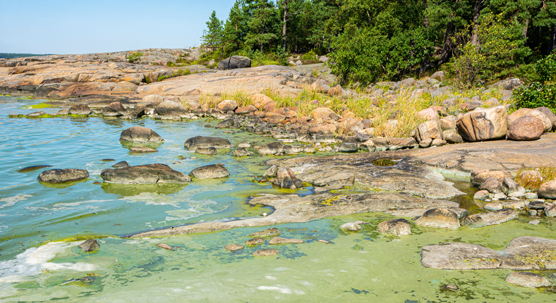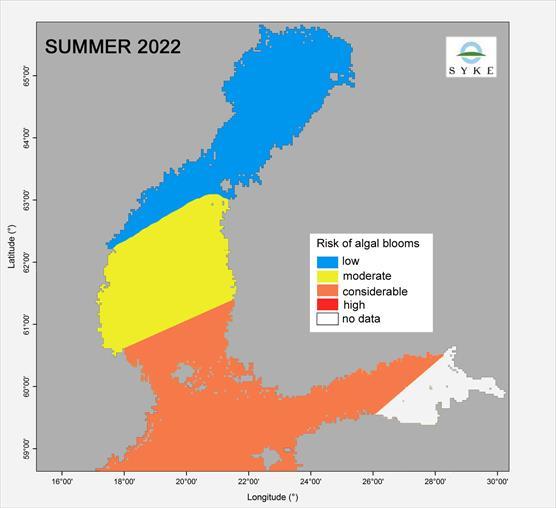Press release 2022-06-02 at 9:00

The cyanobacterial situation varies from summer to summer, according to the weather conditions. © Adobe Stock
The cyanobacterial bloom risk is considerable in the Gulf of Finland, the Archipelago Sea and the southern parts of the Bothnian Sea. The risk this summer is at the same level as previous summers.
The risk of large cyanobacterial blooms in Finnish sea areas this summer remains at the same level as previous summers, as nutrient levels in the Baltic Sea remain largely unchanged. The risk of cyanobacterial accumulations is considerable in the northern parts of the Baltic Proper, in the Gulf of Finland, the Archipelago Sea and in the southern parts of the Bothnian Sea. In the Bothnian Sea, cyanobacterial blooms are not necessarily limited to the southern areas.
The final cyanobacterial situation and the occurrence of cyanobacterial surface accumulations will be determined by summer weather conditions. This cyanobacterial forecast only gives an overall assessment of the cyanobacterial situation for the summer. The cyanobacterial situation can change rapidly, and local variations can be significant.

Algae bloom risks 2022. White area not evaluated due to lack of winter nutrient data. © SYKE
Summer weather influences the occurrence of cyanobacterial surface rafts
Blue-green algae thrive in warm water. The formation of abundant blooms requires favorable conditions that last for about two weeks. Whether the rafts that form in the open sea drift towards the coasts will depend on winds and surface currents. From the Gulf of Finland, a cyanobacterial surface accumulation can drift towards the Finnish archipelago and the southern coast when southern winds are prevailing. Local cyanobacterial blooms will be observed throughout the coastal areas during the summer.
Cyanobacterial blooms typically become more abundant in early July, with a summertime peak occurring in the second half of July and early August.
Surface raft formation and mixing can happen quickly
Cyanobacterial blooms occur especially during long periods of calm and warm weather. In calm weather, algae that have been mixed with water rise to the surface and form large accumulations. Even a weak wind can drive blue-green algae to accumulate in the coastal waters and on beaches. Strong winds cause the algae to mix with the water, making them more difficult to detect.
“The weather conditions during the coming summer will have a significant impact on what the cyanobacterial situation will look like this summer. This risk assessment, made at the beginning of the summer, is able to describe the likely areas for cyanobacterial blooms, but it is nevertheless advisable to follow the regional development of the cyanobacterial situation in the weekly algal reviews. It is also worth monitoring the local situation oneself. Observations of the occurrence and non-occurrence of cyanobacteria can be saved in Järvi-Meriwiki, where they can be seen by others,” says Senior Research Scientist Jouni Lehtoranta from the Finnish Environment Institute (SYKE).
The situation in the Baltic Proper means the cyanobacterial bloom risk remains considerable
SYKE has been making cyanobacterial forecasts every summer for ten years. During this period, the salt stratification in the Baltic Proper has weakened the mixing of water and kept the oxygen conditions poor and phosphorus levels high in the deep waters of the main basin poor. This water, which is low in oxygen and rich in nutrients, ends occasionally up in the Gulf of Finland, the Archipelago Sea and also the Bothnian Sea. Despite the decrease in nutrient load, the poor condition of the Baltic Proper maintains the current level of eutrophication in the Finnish sea areas and the risk of the occurrence of blue-green algae.
“During the last decade, the regional risk of blue-green algae has remained largely unchanged. However, in the southern parts of the Bothnian Sea, the risk has increased. Only an improvement in the condition of the Baltic Proper would significantly reduce the risk of cyanobacterial blooms,” says Development Manager Mika Raateoja from SYKE.
Cyanobacterial blooms should always be treated with caution as they may pose a health hazard to humans and domestic animals. Some species of cyanobacteria produce toxins, and the toxicity of the algae cannot be assessed visually.
The risk assessment of cyanobacterial blooms is based on the nutrient levels measured by the Finnish Environment Institute, the Swedish Meteorological and Hydrological Institute and the University of Umeå last winter. SYKE evaluates the risk of algal blooms using the Baltic Sea ecosystem model. The final assessment utilizes the nutrient data obtained by monitoring the Baltic Sea in spring 2022.
National algal reviews are published again
The Finnish Environment Institute SYKE will report on the cyanobacterial situation every week until the end of August. The first algae review of the summer will be published today, 2 June 2022, at 13.00.
Inquiries:
Algal bloom risk assessment in Finnish sea areas:
-
Jouni Lehtoranta, Senior Research Scientist, Finnish Environment Institute SYKE, firstname.lastname@syke.fi, tel. +358 295 251 363
-
Mika Raateoja, Development Manager, SYKE, firstname.lastname@syke.fi, tel. +358 295 251 536
-
Eija Järvinen, Communications Specialist, SYKE, firstname.lastname@syke.fi, tel. +358 295 251 242
-
Map image for media use (Pdf)
-
Järvi-meriwiki